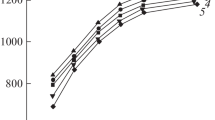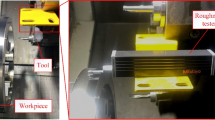Abstract
CBN is to be seen as a further development in cutting tools. CBN is the second hardest known substance and because of its physical properties, many advantages appear when using CBN tooling as an alternative to tungsten carbide or to grinding operations. In the present investigation, CBN cutting edges were used in turning tests of the materials 50CrMo4, 16MnCr5, 90MnV8, and X210CrW12; all of them provided a hardness of at least 55 HRC. Even though the cost of CBN cutting edges is relatively high in relation to tungsten carbide, the results of the tests performed show that an economical usage of the new cutting material is possible for turning operations. The wear behavior of CBN cutting edges is characterized by crater and flank wear, as well as small cracks on the cutting edge, depending upon the cutting conditions. The surface quality of the machined workpieces is fairly good and remained good even though relatively long cutting times were reached.
Similar content being viewed by others
Abbreviations
- VB:
-
flank wear land [µm]
- t:
-
cutting time [min]
- v:
-
cutting speed [m/min]
- s:
-
feed rate [mm]
- T:
-
tool life [min]
- KT:
-
depth of crater [µm]
- Fs :
-
cutting force component in cutting direction [N]
- Fv :
-
cutting force component in feed direction [N]
- Fp :
-
cutting force component in tool holder direction [N]
References
K. Ichinose, M. Wakatsuki, T. Aoki, and Y. Maeda:Proc. Int. Conf. High Pressure 4th, 1974 (Publ. 1975), pp. 436–40.
M. Wakatsuki and K. Ichinose:Proc. Int. Conf. High Pressure, 4th (Publ. 1975), pp. 441–45.
T. Soma, A. Sawaoka, and S. Saito:Proc. Int. Conf. High Pressure, 4th, 1974 (Publ. 1975), pp. 446–53.
R. C. DeVries:Cubic Boron Nitride: Handbook of Properties, Technical Information Series, General Electric Company, Corporate Research and Development, June 1972.
R. E. Hannemann and L. E. Hibbs: SME Technical Paper 143, 1973.
F.W. Gorsler: SME Technical Paper 145, 1973.
K. Grey:Fertigungstechnik und Betrieb 27, 1977, nr. 10, pp. 599–601.
N. Narutaki and Yasuo Yamane:Annals of the CIRP 28, 1979, vol. 1, pp. 23–28.
H.K. Toenshoff and G. Chryssolouris:Werkstatt und Betrieb 114, 1981, vol. 1, pp. 45–49.
O. Kienzle:Z. VDI 94, 1952, pp. 299–305.
A. I. Pekelharing:Microtecnic 14, 1960, no. 2, pp. 68–79.
F. Betz:Fertigung, 1970, no. 1, pp. 9–14.
Author information
Authors and Affiliations
Rights and permissions
About this article
Cite this article
Chryssolouris, G. Turning of hardened steels using CBN tools. J. Applied Metalworking 2, 100–106 (1982). https://doi.org/10.1007/BF02834207
Issue Date:
DOI: https://doi.org/10.1007/BF02834207




